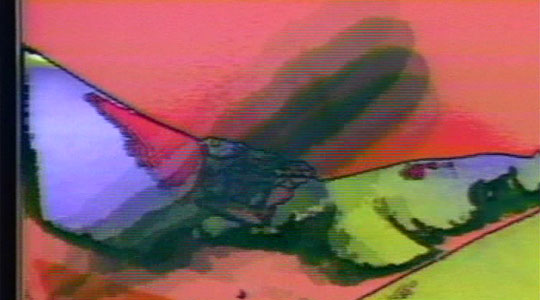Nam June Paik
[KR]

“Global Groove“ (1973)
Distributed by LIMA - Amsterdam
“This is a glimpse of the video landscape of tomorrow, when you will be able to switch to a ny TV station on the earth, and TV Guides will be as fat as the Manhattan telephone book”. So begins Global Groove, a seminal work in the history of video art.
ny TV station on the earth, and TV Guides will be as fat as the Manhattan telephone book”. So begins Global Groove, a seminal work in the history of video art.
This radical manifesto on global communications in a media-saturated world is rendered as a frenetic electronic collage, a sound and image pastiche that subverts the language of television. With surreal visual wit and a neo-Dada sensibility, Paik manipulates an emblematic pastiche of multicultural elements, art world figures, and pop iconography. Pepsi commercials appropriated from Japanese television are juxtaposed with performances by avant-garde artists John Cage, Merce Cunningham, Allen Ginsberg, and the Living Theatre. Scenes of dancers moving in a synthesized, colourized space to Mitch Ryder's Devil with a Blue Dress On are interspersed with traditional Korean dancers. Charlotte Moorman, her image wildly synthesized, plays the TV Cello; Paik and Moorman play the TV Bra for Living Sculpture; Richard Nixon's face is distorted by a magnetically altered television.
In an ironic form of interactive television, Paik presents Participation TV, in which he instructs viewers to open or close their eyes. Paik subjects this transcultural and intertextual content to an exuberant, stream-of-consciousness onslaught of disruptive editing and technological devices, including audio and video synthesis, colourization, ironic juxtapositions, temporal shifts and layering – a controlled chaos that suggests a hallucinatory romp through the channels of a global TV.
With its postmodern content, form, and conceptual strategies, Global Groove has had a profound influence on video, television, and contemporary art.
Nam June Paik studied music, (art) history, and philosophy in Tokyo. He later moved to West Germany to study music history and musical composition, where he met John Cage, who would have a big influence on Paik's compositions. Through contacts with Wolf Vostell and Joseph Beuys, Paik then became involved in the Fluxus movement at its very beginning. In 1964 he moved to New York City and began a long collaboration with avant-garde cellist Charlotte Moorman. Together, they created a series of controversial and notorious pieces in which they combined audio, video, and performance.
According to an enduring (and unverifiable) tale about the origins of video art, Paik shot images of the Pope during his visit to New York in 1965, using the first portable video camera that was commercially available to allegedly create the first piece of video art in history. He would later focus on creating spatial installations with video and sound. He continued pioneering work with technological media, and often developed his own electronic devices to achieve a desired effect. By using television monitors and bright moving images in a critical and artistic way, he created a counterpart to the growing commercial use of television as a mass medium. In 2006 Paik died in Miami, a decade after he had suffered a stroke that left him partially paralyzed.


